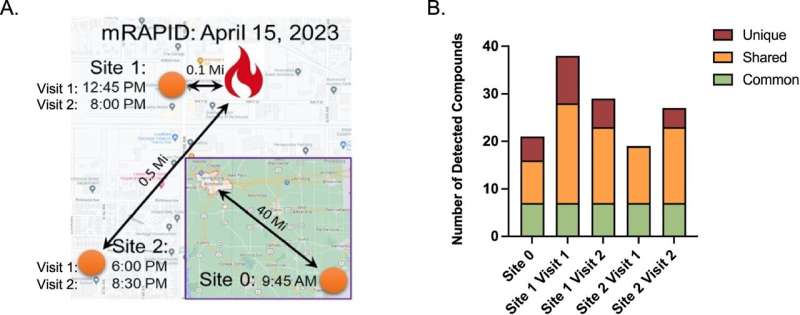This article has been reviewed according to Science X's editorial process and policies. Editors have highlighted the following attributes while ensuring the content's credibility:
fact-checked
trusted source
proofread
Novel mobile air monitoring technology yields greater insight into post-disaster pollution levels

A team including researchers from the Texas A&M University School of Public Health and School of Medicine has found that high resolution mass spectrometry could be a valuable tool for identifying and assessing air-borne contaminants produced by natural and man-made disasters. Their findings are published in the Journal of Exposure Science & Environmental Epidemiology.
The scientists used high resolution mass spectrometry—a highly accurate means of identifying molecular compounds in a sample—in fall 2023 to identify volatile organic compounds (VOCs) present following a major fire that occurred on April 11, 2023, in Richmond, Indiana. The fire and subsequent explosions at the My Way plastic recycling plant led to the evacuation of residents in a half-mile radius from the facility. The fire was sufficiently large to be captured in satellite images, and debris was found as far away as Oxford, Ohio, nearly 30 miles from the site.
"The Environmental Protection Agency does extensive, long-term recovery work after disasters like this," said researcher Natalie Johnson, Ph.D., from the Department of Environmental & Occupational Health. "We believe that our study proves this method produces accurate data very quickly, which could help officials determine the best evacuation zones following a disaster."
Others on the team were Eva C.M. Vitucci, Ph.D., a postdoctoral student in the Department of Environmental and Occupational Health, Carolyn L. Cannon, MD, Ph.D., from the Texas A&M School of Medicine and two colleagues from Carnegie Mellon University.
The team monitored the air within and bordering the half-mile evacuation zone using high resolution mass spectrometry and non-targeted analysis, a relatively new computational tool for detecting and identifying chemicals in environmental exposures.
Johnson said this approach is an improvement over the ones currently used in the field, which frequently have issues with instrument sensitivity, time limitations in sampling and ability to characterize a broad range of pollutants. Non-targeted analysis, on the other hand, quickly and effectively identifies all the compounds—even those not known to be present initially. While this approach has shown promise in previous tests, this was the first time it was applied to a real-world disaster.
After receiving training and guidance on the Hazard Comparison Module by Antony Williams of US-EPA's Center for Computational Toxicology and Exposure, the team used the module to create a risk assessment from the VOCs present. Their analysis identified 46 VOCs, and the average levels in the area studied were higher than those they found in Middleton, Ohio, about 520 miles away.
The levels of hydrogen cyanide—which disrupts the body's use of oxygen and can cause death—and four other VOCs were at least 1.8-fold higher near the incidence site. Of the 46 VOCs, approximately 45 percent were classified as high hazards, and 39 percent were classified as very high hazards.
"Each of the VOC levels we detected were individually below the hazard thresholds for single exposures, but we currently do not fully understand what the hazard thresholds would be for exposure to VOC mixtures such as these," Johnson said.
She noted that facilities such as My Way contain large amounts of harmful toxins, and a large number of different toxins, which makes prediction of the VOCs produced in fires and similar disasters difficult.
"Fires at recycling plants and other typically smaller-scale disasters are usually overlooked as contributors to pollution levels, but they also are happening more frequently across the United States," Johnson said. "This makes research and the application of research findings a pressing public health issue."
More information: Eva C. M. Vitucci et al, The application of PTR-MS and non-targeted analysis to characterize VOCs emitted from a plastic recycling facility fire, Journal of Exposure Science & Environmental Epidemiology (2024). DOI: 10.1038/s41370-024-00681-y
Provided by Texas A&M University




















